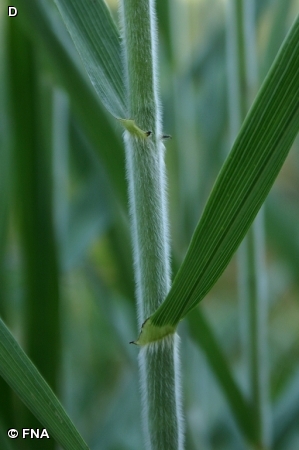
A native perennial from 2 1/2 – 5 feet tall growing singly or in bunches, often in large, loosely-spaced groups. Leaves are numerous, usually more than 10 (B,C). Their overlapping sheaths, usually covered with dense, fine grayish hairs, (D) completely cover the underlying smooth stem and nodes (E). Projections called auricles extend backward at the base of the leaf (F). The upright or leaning flowering stem has a moderately dense drooping 6-10 inch long panicle at its tip (A).
Moist woodlands, in both upland and floodplain, but more common on the floodplain. In Fontenelle Forest Ear-leaf Brome is common on Missouri Trail near the river and at the south end of Gifford Memorial Boardwalk. At Neale Woods there is a large local population in the opening near the south side of the pond on River Road. It is rare in the uplands. An occasional upland plant has been seen in the Nebraska Prairie area at Neale Woods. Flowering occurs from August to October.
Common Woodreed (Cinna arundinacea) occupies similar sites and flowers at the same time, but has an erect panicle, hairless leaf sheaths and no auricles. Canada Brome (Bromus pubescens) has a similar nodding panicle but flowers much earlier (May/June), has fewer leaves (less than 10 per stem) and no auricles. Smooth Brome (Bromus inermis) also flowers earlier, has an upright panicle and smooth, hairless stems and sheaths.
The content of NatureSearch is provided by dedicated volunteer Naturalists of Fontenelle Forest who strive to provide the most accurate information available. Contributors of the images retain their copyrights. The point of contact for this page is: Neal Ratzlaff.





